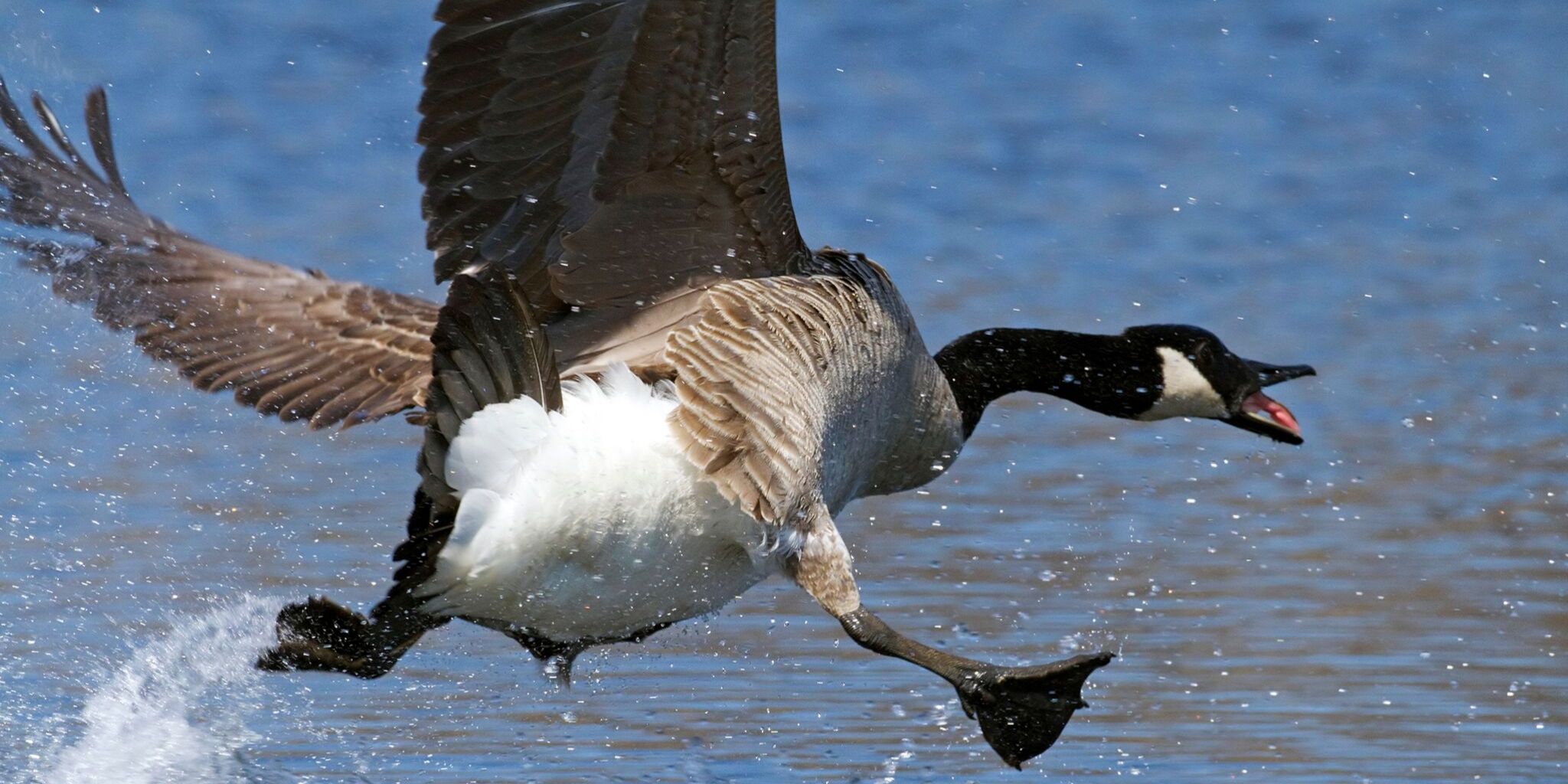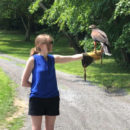We have much more to do and your continued support is needed now more than ever.
The Untitled Goose Blog

Last week, gaming company Panic released a new video game called the “Untitled Goose Game,” which took the internet by storm. In the game (available only for Nintendo Switch or PC + Mac), users play as a goose wreaking havoc in a small village in rural Britain. The player is given tasks like honking at humans; putting a rake in a lake; stealing items like keys, glasses, toys, and tools; honking some more; and generally causing mayhem.
The (anti)-hero of the Untitled Goose Game is most similar to an Emden goose, a domestic goose commonly bred in Europe. In the U.S., however, the most common type of goose people interact with is the Canada goose ーa wild species whose range stretches from Canada to Mexico. If you live in the continental U.S., chances are you’ve seen these geese roaming in a nearby park and heard them honking as they fly overhead.
While the goose in the game plays on the stereotype of geese as angry, mischievous creatures held by most people who have ever interacted with a goose on any continent, we of course can’t ascribe malicious intentions to animals like we would to humans. While they might have earned this reputation, geese are just being geese, doing what comes naturally to them.
Being loud, aggressive, and adaptable is a survival strategy in a world filled with potential predators and changing habitats. Yet somehow their plucky attitudes and bossy personalities make them more endearing. While there’s no denying that geese can sometimes be a nuisance, let’s unpack the reasons behind that behavior.
Laury Sahakangas
1) They Aggressively Defend Their Nests
Geese generally aren’t afraid of humans, since they tend to exist in such close proximity with them throughout their ranges, and become easily accustomed to them. This can sometimes lead to hostile interactions between humans and geese, especially if the goose is a parent defending its young. If a parent goose feels it or its babies are threatened, it may hiss, flap its wings, or snap at the human ー and in some cases, it will chase after them.
If being chased by a large, angry goose isn’t scary enough to imagine, it’s even more terrifying when you know that geese have serrated tongues and bills. While they mostly use this evolutionary feature to graze on the fibrous stems of the grasses and strip tough grains from their stems, it can make their bite painful and is another reason to avoid making them feel threatened.
You can prevent human-goose conflict in a similar way to how you’d prevent conflict with any other wildlife ー keep your distance. Remember that most Canada geese are migratory and will probably only be in your area for a short time of the year. And if you see a parent with babies, maintain a safe distance so the birds don’t feel threatened.
2) They Honk
In the spring and fall, huge V-shaped flocks of geese can be seen ー and heard ーflying overhead in their seasonal migration patterns. Their loud honking calls can be obnoxious to humans on the ground, but those calls are vitally important to keeping the flock together. Geese often fly overnight, when temperatures are cooler and the air is less turbulent. The V-shape of their migration pattern allows them to conserve energy and travel farther distances ーup to 1,500 miles at a time!
You can avoid the nuisance of loud goose honking by sleeping with earplugs during migration season or covering your ears when you see their characteristic V-shaped migration pattern approaching.
3) They Poop – A Lot
Those who maintain golf courses, public parks, community open space, and private lawns may face the approach of goose migration season with a deep sense of dread. These landscapes ー generally flat, open spaces with no place for predators to hide and with a lot of grass for food ー are the perfect habitat for geese to thrive, especially if there’s a body of water nearby. And, where geese like to eat, there tends to be a large accumulation of goose waste as well. What goes in must come out!
You can protect yourself from the accumulation of goose waste in your lawn by reducing the amount of open, grassy space around your home or community. Consider creating a wildlife habitat garden with dense plantings of native shrubs, trees and wildflowers ー which ironically will make the landscape less attractive to geese ー or using these Five Ways to Make Your Lawn Better. Your lawn ー and the other wildlife around your home ー will thank you!
4) They Can Interfere With Airports and Airplanes
Canada geese are sometimes cited as the source of flight delays and even accidents. In some areas, they can block runways and prevent planes from taking off. They have also been cited on rare occasions as the causes of plane malfunctions. An analysis of Flight 1549, which made an emergency landing in the Hudson River in 2009, found that the plane had likely struck a flock of geese over the Bronx Zoo, which caused the engines to malfunction.
This kind of occurrence is extremely rare and highly unlikely. As such, we don’t have recommendations for avoiding this scenario. Many airlines already take precautions to keep geese off of the runways and away from planes, including playing sounds of warning calls from other geese as a deterrent and employing specially-trained dogs to keep geese from congregating near airport runways.
5) They Can Carry Diseases
As mentioned above, geese can leave a large amount of feces and other waste behind on grassy areas. This can carry bacteria, parasites, and other diseases that mostly affect other birds, but which can sometimes be transmitted to humans (although this is very rare). You can avoid exposure by avoiding contact with goose droppings, and by ensuring proper disposal of landscaping waste.
Canada geese aren’t endangered or species of concern ー in fact, due to their ability to thrive in human-developed areas, their populations have steadily increased in the past several decades. However, they are still native wildlife and important players of the natural food web, and the ecosystems where they live. You can help protect geese by not feeding them and by keeping your distance.
Feeding geese human foods like bread and popcorn may seem like a fun way to bond with wildlife, but their systems aren’t able to process this kind of food and it can sicken them. Additionally, if they learn to expect food from humans, they can become dependent and lose their willingness to seek food in the natural environment. This also heightens the risk of aggressive interactions with humans.
Here at the National Wildlife Federation headquarters, we’re already having a great time solving puzzles to cause the greatest mayhem in the Untitled Goose Game. We hope you’re able to get in touch with your mischievous side, too! Just remember ー IRL geese are still animals, and we need to keep them wild. If you follow the basic rules of not feeding them and respecting their personal space, geese can indeed be pretty cool wildlife neighbors!
Like what you read? Please consider making a donation to support our critical conservation work:






















